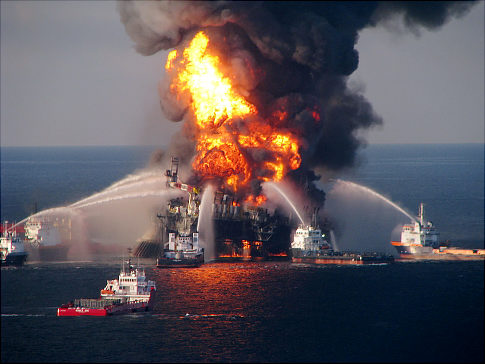By Karen Corey
Love Canal. Chernobyl. Bhopal. Three Mile Island. Deepwater Horizon. Fukushima.
Each of these is a place that has become synonymous with environmental disaster, provoking environmental regulation and concerns about large-scale environmental devastation. Few people argue with the necessity of investing money to rehabilitate Superfund sites or radiation-contaminated zones. But long-term, chronic environmental stressors are other matters altogether. How do we decide who pays for natural arsenic contamination in our water – and is it worth paying for? Who will pay for the costs associated with climate change – and how do we measure the benefits of regulations that attempt to mitigate it?

Executive Director, Institute for Policy Integrity
Three distinguished panelists gathered to discuss this question last week, providing the audience with legal, economic, and scientific background on the challenges of measuring the costs of climate change – and the benefits of reducing greenhouse gas emissions. According to Michael Livermore, Executive Director of the Institute for Policy Integrity, the legal requirement for cost-benefit analysis is at the heart of the issue. Beginning under the Reagan administration, proposed government regulations must be submitted to review by a little-known office called the Office of Information and Regulatory Affairs (OIRA). Most of these regulations must pass the cost-benefit test; that is, the total costs of the regulations must be less than the benefits we will receive from the regulation. Surprisingly to me (and I bet quite a lot of people), Mr. Livermore claimed that strict environmental regulation usually shows significant environmental benefits – for every $1 invested in reducing mercury emissions, $8 in benefits has been produced. That’s a better investment ratio than just about anything else out there.
Cost-benefit analysis (CBA) is a widely used tool, but often runs into some measurement problems. Livermore gave the example of reducing smokestack emissions. It’s easy to measure the costs of such a policy – figure out how much it costs to install scrubbers or some other emissions-reducing technology, multiply by the numbers of systems that needs to be installed, include some number for the cost of labor and need for a slight increase in production – and you have a nice number for costs. But what about the benefits? Where do we find the dollar figure associated with benefits of reducing smokestack emissions? This is where the measuring gets tricky.
the example of reducing smokestack emissions. It’s easy to measure the costs of such a policy – figure out how much it costs to install scrubbers or some other emissions-reducing technology, multiply by the numbers of systems that needs to be installed, include some number for the cost of labor and need for a slight increase in production – and you have a nice number for costs. But what about the benefits? Where do we find the dollar figure associated with benefits of reducing smokestack emissions? This is where the measuring gets tricky.

Energy-efficient vending machines: providing you with soda and climate change policy!
An Interagency Working Group, led by the EPA, was convened to come up with a number for the benefits of reducing greenhouse gas emissions. Of all things, the group was convened as part of a regulatory discussion on energy efficiency standards for vending machines, said Mr. Livermore. The group’s task: Figure out the economic value of NOT emitting one ton of carbon dioxide – this value is known as the social cost of carbon. Once this number was estimated, it could be used in any regulatory decision that involved regulating GHG emissions – from fuel economy standards to electricity generation.
How is this number produced? All three speakers offered complex diagrams of the modeling structure that goes into the estimate, but in the end, it boils down to this: using a number of estimates of what the effects of climate change will be in a hundred years or so, economists assign some kind of dollar value to some of these effects, and then total it up.

The main problem is this: many of the effects are either not included in the model, not monetized, or completely uncertain. For example, we can estimate what the crop losses will be if the temperature rises 10 degrees and then multiply that number by the cost of each crop. But what if crop prices rise dramatically because food is so scarce? Today’s commodity prices will not longer be accurate. What about the public health effects of rising global temperatures? The models used by the interagency working group don’t include numbers like how mortality and morbidity from heat-related illness will increase, how vector-borne diseases (diseases like malaria, dengue fever, and others, which are carried by bugs) will proliferate, causing decreased productivity and higher health care costs.

Eventually, the Interagency Working Group came up with a central estimate of the social cost of carbon: $21 per ton of carbon dioxide emitted. Many economists and climate scientists, including the panel’s second panelist, believe that this number is much too low. Dr. Laurie Johnson, chief economist at the Natural Resources Defense Council, performed her own estimation of the SCC, using the same model as the interagency working group. Her values of the SCC range from $55 to $266 per ton – but she cautions that even those estimates may be too low, since they are based on a mid-range climate projection. A worst-case scenario would be associated with much higher costs. These numbers reflect other recent independent estimates of the SCC – in 2011, the group Economics for Equity and the Environment (E3) estimated that the SCC could be $900 in a worst-case scenario.
What causes the discrepancy between the estimates if the same models and assumptions are being used? The debate among economists revolves around the discount rate – used by economists to measure the present value of something in the future. The higher the discount rate, the less that future money is worth today. The discount rate is based on several assumptions:
- We will all be wealthier in the future than we are today.
- We would rather spend our money today than save for the future.
Dr. Johnson argues that the federal government chose a discount rate that was too high – 2% for the central estimate – and one that is inappropriate for an intergenerational problem. At its heart, the choice of a discount rate is an ethical problem – choosing a high discount rate makes an assumption about the future and how future generations will feel. Usually, when we make calculations about our finances and think about the discount rate, we are thinking about our own money. I have every right to make a decision about my own income – and so does everyone else. But do I have a right to decide about my children and grandchildren’s future income – or the worth of the world they inherit, a world devastated by climate change because we underestimated the damages associated with greenhouse gas emissions?
Theory aside, how does this SCC number affect us? Did we get more efficient vending machines in the end? I don’t know the answer to that question, but Dr. Johnson provided one example of how the SCC plays into policymaking in the area of electricity generation. One of the main arguments against investing in renewable, clean energy is that it is more expensive than natural gas or even so-called clean coal. This is true – if we ignore the negative externalities associated with fossil-fuel electricity generation. However, if we include the social cost of carbon in the calculation, the costs of electricity generation change dramatically. Even with the federal estimate, including the SCC shows that building new wind generation is cheaper than new natural gas plants. Using the higher estimates suggested by Dr. Johnson, wind plants are seen to be much cheaper, when all the costs are included, than both constructing and operating new natural gas plants, and maintaining existing plants. That point bears repeating:
According to Dr. Johnson, it is cheaper to shut down old coal plants and build new wind stations than it is to continue operating already-existing facilities.

Dr. Johnson’s critique lay mostly with the way that the current damages associated with global climate change are monetized, but the final speaker, Dr. Robert Kopp, hammered home the uncertainty about what the extent of these damages actually will be. Comparing three climate models (DICE 2007, ENVISAGE, and FUND 3.8), Dr. Kopp showed that the models rarely agree about the magnitude of damages in a given sector – and in some cases, the models don’t even agree about whether there will be a net benefit or a net cost. Even more worrying, most of the models don’t even include the costs associated with a catastrophic outcome. What do we mean by a catastrophic outcome? The definition includes extinction of the human race. I’m not sure I know how to monetize that – or want to consider monetizing it.
Although climate models are continually being refined, this knowledge takes time to percolate through the scientific channels. When the Interagency Working Group came up with its SCC number, it did not write its own model and do its own economic valuation – it used previously existing peer-reviewed literature, just as the IPCC does when writing assessment reports. The newest literature – such as the research done by Dr. Kopp – will not play into existing policy-making and inform a new measure of the SCC for a long time to come.
What’s the take-home message? Cost-benefit analysis determines much of the regulation in this country – and measuring costs and benefits is complex and difficult. How we assign these costs can mean the difference between a clean energy future or a fossil-fueled future – the difference between a world that experiences catastrophic climate change or a world that somewhat resembles the world we live in today.

